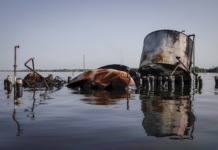[ad_1]
Japan’s post-Fukushima nuclear future is again being questioned in the wake of regulatory authorities’ decision to extend the life of three reactors at two nuclear power plants despite another aftershock.
A decision by the Nuclear Regulation Authority of Japan to extend the life of three reactors at two nuclear power plants in the Fukui Prefecture has rekindled worry about a possible repeat of the 2011 Fukushima disaster, as it comes only a week after the neighboring Fukushima Prefecture was rocked by a 7.4 aftershock.
The decision will see the #3 reactor of Kansai Electric Power Co’s Mihama plant, along with two more, operate for another 20 years, bringing their total lifetime to 60 years. The other two reactors that received a life extension are part of the Takahama power plant.
The earthquake that shook Fukushima last Monday caused a stoppage in the cooling system of the Fukushima Daini nuclear power plant. This could have resulted in the overheating of some 2,500 spent uranium fuel rods; however, a catastrophic accident was avoided by the intervention of the plant’s operator, Tokyo Electric Power Co.
Memories of the 2011 disaster at the Fukushima Daichii plant remain very fresh, adding support to anti-nuclear activism.
Last month, Ryuchi Yoneyama, a lawyer with no previous experience in a public office, won the Niigata Prefecture regional elections, pledging to stop plans that would restart the Kashiwasaki-Kariwa power plant in the prefecture, which neighbors Fukushima to the west. Yoneyama beat Tamio Mori, a career politician supported by PM Shinzo Abe.
Related: Can An OPEC Deal Save Venezuelan Oil From Total Collapse?
The Kashiwasaki-Kariwa plant, though it suffered no damage from the devastating 2011 tsunami, has a problematic history, with several of its reactors shut down in 2007 after radiation leaks following another earthquake.
The Niigata prefecture election was observed as a litmus test for public sentiment towards nuclear power. This sentiment, it turned out, is still problematic for the country’s nuclear industry.
According to a Japan Times report, there are evacuation procedures in place if any of the two NPPs whose lives were just extended suffer the effects of a strong aftershock or any other event that could compromise their safety. Still, these procedures are not deemed optimal by everyone.
These concern a population of about a quarter of a million people living in three neighboring prefectures–Fukui, Shiga, and Kyoto–half of them in Kyoto. A full evacuation of the people living within a 30-kilometer radius of the two Fukui plants was three years ago estimated to take between 15 and 29 hours, depending on the road damage associated with a critical event.
Amid these concerns, natural gas is gaining prominence as the alternative of choice for anti-nuclear activists in one of the world’s developed economies that is most dependent on energy imports.
Related: Oil Comes Back To Life In Canada
According to a report by the Washington Post, as hostility towards nuclear power increases, hopes are growing that under a Trump presidency, the U.S. will increase its LNG exports enough to provide Japan with a real alternative to risky nuclear power.
In the meantime, the Japanese government now estimates that the cost of cleaning up radioactive contamination and compensating victims of the Fukushima 2011 disaster has more than doubled. Originally, the cost was estimated at US$50 billion; later it increased to US$100 billion. It now hovers around US$180 billion. The largest costs are associated with storing contaminated soil and decommissioning.
The rest of the world, however, isn’t necessarily giving nuclear the cold shoulder. While Fukushima has indeed brought nuclear energy sentiment to new lows, according to the International Atomic Energy Agency, there are presently 61 units under construction and another 149 planned.
By Irina Slav for Oilprice.com
More Top Reads From Oilprice.com:
[ad_2]
fuente








